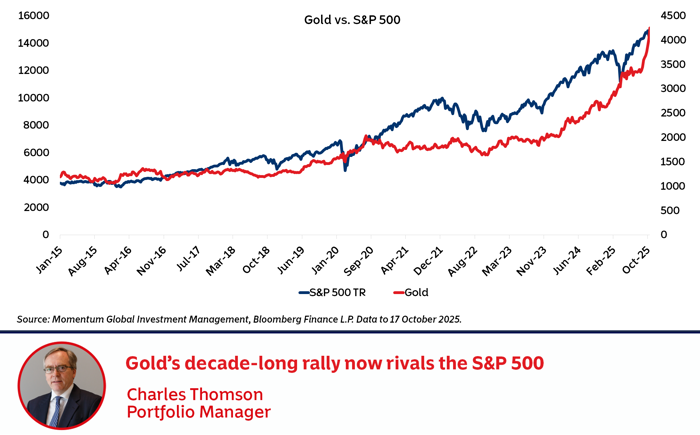
What this chart shows
This chart shows the cumulative return of investing in gold and the S&P 500 Index (with dividends reinvested) over the past 10 years.
Why this is important
The S&P 500 has had an astonishingly high return over the past 10-years of 285%, equivalent to an annual return more than 14 percent. Transformative technologies have created enormous increases in market capitalisation for companies such as Apple, Tesla and Invidia. It is therefore remarkable that gold, a commodity which has little intrinsic value and no cashflow generation, has produced an equivalent return to US equities over the past decade.
The recent surge in gold prices can be attributed to a confluence of factors. Firstly, many central banks, especially those in emerging markets, have stepped up purchases of gold as part of reserve diversification away from G7 currencies and to hedge geopolitical risk. Secondly, large inflows into gold-backed ETFs have provided new avenues of demand from institutional and retail investors alike. And thirdly, hedge funds and other speculators have increasingly positioned for higher gold prices, adding momentum to the rally—as noted by the build-up in net long positions in futures and options markets.
However, it’s worth emphasising the speculative nature of the current advance. Unlike equities or bonds, gold does not generate cash flows (dividends, coupons or earnings) and so its value is heavily determined by capital flows and expectations about inflation, interest rates, central-bank policy and currency moves rather than fundamentals in the traditional sense. This means that when sentiment changes—say if real interest rates rise unexpectedly, the dollar strengthens, or central-bank buying slows—a sharp downside risk emerges. In other words: the very drivers supporting the rally today could reverse, and because gold is difficult to value on a standard discounted-cash-flow basis, losses in this asset class can come more swiftly and without the same warning signs as for yield-producing assets.
Global markets navigated a complex web of political gridlock, modest economic resilience, and shifting trade dynamics, with China’s growth surprising on the upside while the US and Europe grappled with fiscal and institutional strains.

-
US inflation surprise, September CPI softer than expected which sparked a rally on 24th October. The S&P, Nasdaq and Dow hit records as markets ramped up hopes for further Fed cuts.
-
Markets are pricing a sequence of rate cuts after the Fed’s earlier first cut of the year; that outlook underpinned risk-on flows.
-
US-China trade tensions and fresh US trade investigations/possible tariff actions were a recurring theme mid-week, pressuring cyclical names at times.
-
Better-than-expected results from large tech names (Alphabet, Intel, etc.) and AI optimism helped lift equities even as some cyclical/industrial names felt trade-related pressure.

-
Figures released on 24th October showed UK retail sales unexpectedly rose in September, boosted by tech (iPhone launch) and online gold purchases; this surprised economists and lifted sentiment.
-
September core inflation softened slightly, coming in at 3.5% year-on-year versus 3.6% in the prior month.
-
London’s indices (FTSE 100) pushed to multi-month/record highs on the back of global risk appetite and strong bank earnings.
-
NatWest Bank reported a strong quarter (big profit beat/upgrade) and lifted guidance, a focal UK financial story that supported domestic financials.

-
Polls and surveys suggested most economists expect the ECB to hold rates (or keep policy tight) for an extended period. Markets broadly priced a steady euro-area policy stance.
-
European markets rallied with global equities on US data and positive earnings flows, euro-area indices reached gains as risk appetite rose.
-
Senior EU officials publicly lamented regulatory/structural obstacles to cross-border bank consolidation, a reminder of fragmentation that affects bank profitability.
-
IMF/other global agencies flagged a modest slowdown in global growth, but the euro area showed steady inflation near target, informing central-bank caution.

-
China’s Q3 data and related reporting (20th Oct onward) showed slowing growth (domestic demand weak) and elevated structural risks, policy makers signalled moves to boost consumption.
-
The property crisis persisted with fresh reports highlighted continuing distress in China commercial/ residential real-estate with large, distressed sales and mounting losses for foreign investors.
-
In Japan a shift in political leadership (rise of Sanae Takaichi as party leader / new PM prospect) spurred investor bets on more expansionary fiscal/ structural policy, equities rose, bonds sold off, yen weakened.
-
Volatile oil moves mid-week, prices fell earlier on oversupply/ glut concerns but spiked after US sanctions on major Russian producers (Rosneft, Lukoil) on 22-23 October, lifting energy sectors and generating supply-risk talk.
